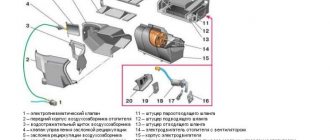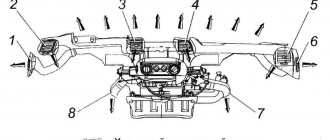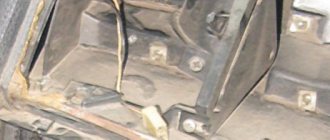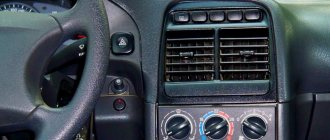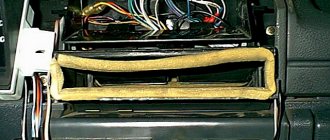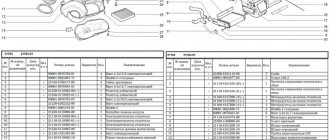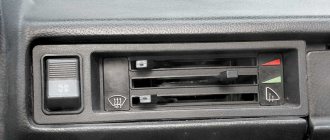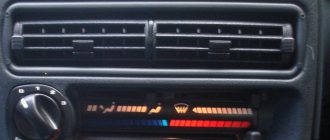With the onset of cold weather, many car enthusiasts notice that the stove on the Lada Kalina does not heat up. The malfunction can be in different elements of the system and sometimes it is not easy to determine the cause. Let's try to figure out in detail how to determine the cause of the malfunction, and then repair the Lada Kalina stove with your own hands.
How to check the operation of the Lada Kalina stove
We carry out all actions with the engine running. Before checking the heater, study the diagram and structure of the Lada Kalina stove.
Checking the ventilation and heating system fan:
- We set the air temperature regulator knob on the control unit to the extreme position of the blue sector.
- We alternately switch the fan speed knob, starting with the first speed and ending with the fourth.
- We check the intensity of the air flow coming from the air ducts. It should get stronger with each switch.
If the heater does not work on the Lada Kalina, check the integrity of fuse F5, as well as its power circuit. If the fan does not operate in all modes, or the air flow intensity does not change linearly, check the additional resistor and switch. If the air flow is weak, replace the cabin air filter.
Checking the stove dampers:
- Set the temperature regulator to the extreme position of the blue sector, and the fan speed to maximum.
- We turn the damper control knob on the block and at the same time monitor changes in the directions of air flows.
Unchangeable air flows indicate a malfunction of the mechanical heater control unit (the draft has flown off, or does not screw onto the roller due to its breakdown), or the damper is jammed. If the car uses climate control, then check the damper micromotor and the ventilation, heater and air conditioning control unit.
- Warm up the engine to operating temperature.
- Turn the air temperature regulator to the extreme position of the red sector.
- Warm or hot air should come out of the air ducts
If the air temperature has not changed, check the serviceability of the mechanical heater control unit (the rod has come off, or does not screw onto the roller due to its breakdown), or the damper is jammed. If the car uses climate control, then check the damper micromotor and the ventilation, heater and air conditioning control unit. Make sure the engine cooling system is working properly.
Checking the interior temperature sensor:
The interior temperature sensor is installed in the lampshade on cars equipped with a climate control system. Most often, a sensor malfunction can be determined by the operating mode of the stove. If only hot or cold air blows from the panel nozzles, regardless of the position of the handle on the heater control unit, then most likely the ceiling air sensor has failed.
DIY heating system repair
To change this or that part of the heating system, it is not at all necessary to seek help from specialists. This will help save time, but not money. If you follow the recommendations, you can replace some system components yourself.
Heater fan
Even beginners can replace the Kalina stove fan. The main problem is its location. For this reason, most of the time is spent not replacing the part, but dismantling it.
Fan replacement with panel removal
The method is recommended by AvtoVAZ engineers, but it is not the simplest. Not everyone decides to use it in a regular garage. When performing work, you must follow the instructions:
- First, turn off the power to the on-board network by disconnecting the battery terminals.
- Drain all coolant and remove the cabin filter.
- After unscrewing the fastening nuts, lower the steering column to its lowest position.
- Release the brake light switch from the wires, unclip the clips, and remove the upholstery from the pillars.
- Unscrew the screws and remove the front panel (cladding), then remove the dashboard along with the deflectors.
- Now you can begin dismantling the fan. To do this, you need to disconnect the terminal with wires from it, remove the ventilation hose, and unscrew the fastening nuts.
After installing the new fan, all further actions are carried out in the reverse order of dismantling. The procedure requires attention and accuracy and takes a lot of time. At some points, the help of a second person will be required.
Replacing a fan without removing the panel
It is not practical to remove the entire dashboard just because of the heater fan. You can replace the device without removing the dashboard - you just need to lift its right side. Next, you should “arm yourself” with a knife and a flashlight and crawl under the panel. The noise insulation is cut off, the fasteners are unscrewed, and replacing the Kalina stove motor becomes much easier. This method will significantly save time and nerves, although it will create some inconvenience.
Before you start replacing the electric fan, you need to make sure that this particular device is faulty.
Replacing the temperature controller
To dismantle the part and replace it, it is necessary to remove the control unit assembly. The procedure looks like this:
- the on-board network is de-energized by removing the “negative” terminal from the battery;
- the radio tape recorder (if any) is removed, and the terminal block of wires is unhooked from it;
- the damper control lever is removed;
- Next, the handle for controlling the temperature and direction of air flow is dismantled;
- there are plugs located at the bottom of the control unit - they need to be removed and the fastening screws underneath must be unscrewed;
- the center console should be carefully pulled towards you;
- After removing the console, disconnect the terminal blocks from the switches.
After replacement, everything is assembled in the reverse order. This operation is simple and only requires a couple of different screwdrivers to get the job done.
Replacing the heater core without removing the panel
Changing the heater radiator on a Lada Kalina, as on all front-wheel drive VAZ cars, is not an easy task. You will have to remove most of the front panel. To work, you will need a new heater radiator, hoses, clamps, an angle grinder and a standard set of tools. First you need to carry out some manipulations in the engine compartment:
- drain antifreeze from the cooling system;
- remove the battery and air filter housing, ensuring unhindered access to the heater pipes;
- you need to disconnect all the rubber pipes from the stove in the engine compartment, unscrew the nut securing the metal shield that covers the hoses going to the stove into the cabin.
Now you need to go to the salon and perform the following steps:
- unscrew the three fastening nuts and remove the gas pedal;
- move the brake pedal as far as possible to the side;
- Having made a cut on the metal shield, cut off the radiator pipes with a knife;
- Unscrew the fastening screws and pull out the heater radiator towards the pedals.
Removing the radiator without removing the panel is only half the battle. It is no less problematic to install it. Before this, the pipes should be thoroughly cleaned of burrs and roughness with fine-grained sandpaper.
A hose with a thicker end is attached to the upper radiator outlet, and a narrower end to the lower outlet. The other ends, without being confused, need to be installed instead of the old ones. It is advisable to treat the place where the hoses from the passenger compartment enter the engine compartment with soundproofing material.
Replacing the stove radiator will help solve the problem of insufficient heating. Due to the labor-intensive nature of most work on troubleshooting a heating system, prices for such services at specialized service stations may seem quite high. It is not surprising that many “folk” repair methods have appeared.
A couple of useful tips
Have you noticed that the heater on the Lada Kalina blows cold? Proceed according to the scheme “from simple to complex”, first check the simplest elements of the heating and ventilation system, for example, the air filter and the presence of coolant. Then gradually move on to more complex design details.
Another good way to find out which part has failed is to replace it with a known working part and check the operation of the system. And you don’t have to buy a new spare part if you borrow it from a friend. You can also try to negotiate with the seller in the store, take a new part for testing, leaving a deposit.
Changing the radiator
If during the inspection it is determined that the radiator is faulty, then it must be repaired or replaced. The design of Kalina is such that this unit is not very conveniently located. It may take a long time to get to him. There are two options for replacing or repairing a radiator - contact a service center for help or act independently. If you decide to try your hand and spend a few “unforgettable” hours in your own garage, we will tell you how to remove and replace the radiator.
- drain the coolant;
- remove the battery (including the stand);
- remove the air filter and air duct;
- remove the driver's seat;
- release the gas and brake pedals (then they will need to be moved to the side);
- dismantle the power steering;
- disconnect the tubes and take out the radiator.
Installation of a new unit is carried out in the reverse order. When performing the operation, carefully fold the parts in the order in which they were removed. Otherwise, you will spend even more time figuring out where and what part to install. To replace the radiator, ask friends for help. It is better if it is 2-3 people.
A possible reason why the heater may blow cold air is an antifreeze leak. The most obvious sign of such a malfunction is that heat is supplied to the cabin only at high speeds. Determine where the fluid is dripping and fix the problem. Add antifreeze. The cabin will be warm.
Statistics of malfunctions of the Lada Kalina stove
According to the results of the survey “ Why does the stove heat poorly on the Lada Kalina? » the main causes of the malfunction were identified:
- 32% voted for problems with the heater damper.
- 14% of votes were given for a faulty heater fan.
- The same number of votes (13%) were given for a failed ventilation and heating system control unit and a faulty heater radiator (replacement).
- For 9% of survey participants, the fault in the heater’s malfunction was the damper’s micromotor reducer.
The remaining votes were given for other problems with the Lada Kalina stove: a faulty additional resistor for the stove, a cabin temperature sensor and a dirty cabin filter.
Let us remind you that you can find various modifications to the car systems in the Lada Kalina tuning section.
Often, car owners think about the serviceability of the stove only at the beginning of winter. But sometimes it can fail. Kalina is no exception. On it, like on many other Volga-made cars, the stove breaks down. For what reasons does this happen, and how to fix this problem? All this will be discussed further in our article.
Tips for solving the problem of cold air from the stove
In order to make the stove work in warm air mode, you need:
- To blow warm air and heat the windows, you can install additional blowers, especially for the Lada Kalina.
- You can also install cardboard on the radiator to help the car warm up better. This “old-fashioned” method is known to almost all motorists.
- Regularly changing the cabin filter is one of the ways to solve the problem of lack of heating. If the filter is clogged, it creates additional stress on the stove.
- It is important to constantly check the coolant level in the expansion tank.
- Check the operation of the thermostat. If the engine is hot and the radiator is cold, then the thermostat is faulty. A hot radiator indicates that the problem is not with the thermostat.
There are times when the cooling system malfunctions due to an air lock getting into it. You can get rid of it like this:
- open the cap on the hot engine of the expansion tank;
- If you hear a crackling sound and the cooling level rises, then you need to repeat this procedure several times at short intervals. It should disappear after a short time. If it does not go away, then the problem is in the valve.
A broken cable can also cause a malfunction in the Lada Kalina stove. If the cable has come off the stove, then this problem needs to be solved as soon as possible. If you have experience in mechanics and have some knowledge, then you can fix all these breakdowns yourself, bypassing the service center. You can also contact a service station, where such malfunctions will be quickly resolved. In cold weather, proper interior heating is more important than ever. That is why it is necessary to ensure in advance that it always functions smoothly and properly.
Coolant
As you know, the cabin heater has its own radiator. It is filled with coolant. This design is part of the main cooling system. If the stove on the Lada Kalina does not heat well, the reasons may lie in the low level of antifreeze. Open the hood and check the level in the expansion tank. It should be between the minimum and maximum marks.
Thermostat
This is another reason why the stove on Kalina does not heat well. The problem is that the flow of antifreeze is directed to the cabin heater only after the coolant has warmed up in a small circle. A thermostat is a kind of valve that controls the flow of fluid in the system. As soon as the temperature of the antifreeze in the small circle exceeds 72 degrees (or 82, depending on the brand), it opens and circulates in the large circle.
- With dismantling. In this case, the element is removed from the car (the antifreeze is first drained into a clean container). Next, it is placed in a small saucepan filled with water and heated on the stove. At this time, monitor the movement of the valve. If the water begins to bubble and the thermostat has not yet opened, it means that it has become unusable. The element may simply jam. This doesn’t happen often, but it is because of this part that the car suffers from overheating and problems with the cabin heater.
- On the spot. In this situation, you should warm up the engine to operating temperatures. Next you need to find the upper and lower radiator hoses. Wearing gloves, you should touch each of them in turn. If the pipe is cold on a warm engine, it means that the antifreeze circulates only in a small circle. The thermostat cannot be repaired and must be replaced entirely. Fortunately, its cost is low - about 200 rubles.
Non-working fans
As we already know, the radiator heats up when hot liquid enters. The heat from the hot radiator is then blown away by fans. Usually there are two of them, and if at least one of them refuses to work, then the heating efficiency will drop significantly. It may even happen that hot air will come from the right side of the cabin, but there will be no air flow from the left side at all. In reviews, car owners write about similar problems with the heating system. This problem is solved by replacing one of the stove fans or replacing the entire stove.
Sensor
If the stove on the Kalina does not heat, this may be the reason. The fact is that on Kalinas there is a sensor installed in the ceiling (near the lampshade) that senses the interior temperature. It may affect the operation of the heater. The electronics compares the received data on air heating with those set by the driver, and thus adjusts the position of the dampers.
Cabin filter
In addition to the air filter, Kalina also has a cabin filter. It is responsible for cleaning the air entering the cabin. The element must be changed every 10 thousand kilometers (in extreme conditions - every 5). If the stove on the Kalina does not heat, this may be the reason. In this case, the intensity of the flow itself will drop significantly. Air will blow weakly from the nozzles. The way out of the situation is to install a new cabin filter. It costs about 300 rubles. To replace, you need to open the hood and partially remove the “jabot” under the windshield wipers. Next, open the lid and remove the contaminated element.
We install a new one in its place and close everything with a plastic cover. It is worth noting that both regular paper and carbon filters are available for sale. In addition to dust, the latter also trap bad odors. As reviews note, this filter is much more effective than the standard one. But it doesn’t get dirty any earlier than a normal one. Externally it can be distinguished by color. It is slightly darker (graphite tint predominates).
Weak air flow: Causes
When there is a weak air flow from the nozzles, it is most likely necessary to eliminate one of the reasons listed below.
External radiator blockage
The honeycombs of the stove radiator often become clogged due to debris getting on its outer part. This problem occurs when the car is used without a cabin filter. This problem can be eliminated by dismantling the radiator and washing it at home.
Dirty filter
When driving on gravel or country roads, the filter collects a large amount of dirt and dust, which over time completely clogs it and makes it more difficult for air to pass through. This is why the stove may have low air flow.
Stove motor
This is another reason why the stove does not heat up on the Lada Kalina. But if in previous cases, when the heater was turned on, a distinct sound of the fan was heard, then here it will be absent. First of all, you should check the serviceability of the fuse in the block. On Kalina, element F5 is responsible for the operation of the heater motor. Sometimes the mechanism may work, but with strange sounds or interruptions.
So, we found out the malfunction of the stove on Kalina and how to fix this problem.
In cold weather, owners of viburnum often begin to have problems with the operation of the stove at idle speed. For example, when you warm up the car, the engine temperature is already rising, and cold air is still blowing from the heater; when the gas is turned on, the heater begins to blow warm or hot air with the characteristic murmur of water under the instrument panel. These symptoms indicate that there is air in the engine cooling system.
Air enters the system mainly due to leaky connections of the pipes, as well as incorrect operation of the expansion tank plug.
The stove does not heat up at idle: reasons and solution
Does the heater blow cold air at idle, and warm air at increased speeds? What is the reason and how to eliminate it. We will consider these and other questions in the article and give detailed answers. Not philosophically abstract. Accurate, because technology does not like understatement. Just something complicated.
Before we say the reason why in 90% of cases the stove does not heat up at idle , let's consider how the car's heating system works as a whole. A little. For understanding. How the stove works: main components, relationships
Structurally, the heating system consists of a radiator, pipes for circulating coolant (coolant, antifreeze), a flow regulator, air ducts, dampers and a fan. The process goes like this:
- pipes supply liquid to the radiator;
- then it circulates through the cooling and heating systems using a special pump;
- As soon as the engine starts to heat up, heat exchange occurs. Antifreeze takes the heat from the engine, cooling it and supplying a warm flow to the radiator, which heats up according to the principle of a regular (apartment) battery;
- at the same time, the stove fan drives cold air from the engine compartment through the radiator honeycombs, heating it;
- and again heat exchange occurs - the warm air flow enters the car interior, and the liquid enters the engine, cooling it. And so on in a circle.
This scheme is recognized as classic, the most common and effective. Used on most brands of cars. The temperature supplied to the inside of the car also depends on how well the heater radiator components function. A failure in one of the links leads, in particular, to the fact that the stove does not heat up at idle. And there are several reasons:
- Faulty engine pump.
- Insufficient coolant level.
- Airlock.
- Faulty coolant flow regulator (faucet).
- Clogged radiator.
And in 90% of cases, the radiator is to blame for the supply of cold air from the stove at idle. But more on this below, because the malfunction can also be affected by other components of the system.
Faulty pump
There are often explanations online that the stove only works while moving due to a poorly pumping pump. This statement is only partly correct. At idle, the rotation speed of the pump is low and, accordingly, the circulation of coolant is small. Low heat transfer results in low supply air temperature, which increases with increasing pump performance. More revolutions means the air heats up more.
What to do? Any problems associated with a malfunction of the pump (poor pumping, leaking, acting up, etc.) can be solved by replacing it. No one can give a 100% guarantee, because even with a fully operational pump, there is a possibility that the problem of cold air at idle will remain.
Insufficient coolant level
The stove does not heat up at idle due to a leaky cooling system: the radiator is leaking or the seal of the pipe connections is broken. This causes the antifreeze level to decrease, resulting in insufficient fluid reaching the radiator. And the heater blows cold. What to do? As a rule, adding antifreeze slightly above the set level and/or eliminating leaks and leaks will help solve the problem.
Airlock
The problem is due to a faulty conservator cap and insufficient coolant level. Factors affect the cooling system, in which excess air accumulates, creating an air lock. Due to insufficient circulation at low speeds, the stove blows cold. The air heats up when the speed increases, and when stopped it cools down again.
What to do? Eliminate the root cause: as in the case of system depressurization, add antifreeze, replace the expansion tank cap, bleed the system, blowing out excess air. You can remove the air by standing on an overpass so that the front wheels are higher than the rear wheels. Open the expander cover. At this moment, the air will come out accompanied by a characteristic sound (“gurgling”). Coolant will also leak, so it is important to top it up to the required level.
After this procedure, it is likely that after a while the air lock will form again. This is due to a blown cylinder head gasket. But in this case, the stove does not work well not only at idle.
Faulty coolant flow regulator (faucet)
Wear of the regulator leads to malfunctions in its functioning, that is, the faucet does not open completely. And at XX, there is not enough pressure to “squeeze” the hot liquid into the heater radiator, thereby supplying a warm air flow into the car interior. What to do? Replace the faucet.
Clogged radiator
Over time, scale forms in the radiator, which creates plugs. The obstruction of the lines leads to a decrease in the pressure that supplies warm air. At high speeds there may be an increase, but at idle you won’t get any warmth. What should I do? Theoretically, you can try flushing the radiator yourself. Many auto stores offer special mixtures that destroy salt compounds. But purging and flushing will only work if the lines are not completely clogged.
If there is no circulation in one of the pipes, then it will not be possible to flush it. Replacement only.
Advice may also include checking the thermostat, replacing the filter (if available), and the gasket. But in practice, the stove does not heat up at idle in 90% of cases precisely because of the high wear of the radiator . To avoid such problems, it is recommended to take preventive measures in time.
Use a high-quality cooling mixture, change it regularly, monitor the quality (after draining, for any impurities), do not mix several models of antifreeze.
Operate your car competently and enjoy a warm car in winter.
Source: https://rulikoleso.ru/interesnoe-na-jrepair-ru/agregats/ne-greet-pechka-na-kholostykh-oborotakh-prichiny-i-reshenie
What to do before removing the plug.
First of all, you need to understand why an air lock forms, for this:
- We check for coolant leaks in the connections of the pipes, if there are any, we tighten the clamps or replace them.
- We check the coolant level in the expansion tank; for viburnums, it is advisable to keep the level at or slightly above the maximum.
- We check the correct operation of the expansion tank plug; if the air inlet plug does not work or with noticeable difficulty, then it is better to replace it; below I will explain in more detail about the plug.
- It is also advisable to check whether the interior heater radiator is leaking; this can be done from inside the cabin by removing the right lower side of the panel under your feet and feeling the floors and the heater block itself.
How to remove a plug from the cooling system.
There are 2 main ways:
- Works on all families of Viburnum cars: stand with your face on a good slope, unscrew the cap of the expansion tank and warm up the car until the fan operates. After the radiators and engine have completely warmed up, a trickle of coolant will flow through the return into the expansion tank, if it doesn’t work you need to gas it. We constantly monitor the structure of the incoming liquid; if it foams and there are clearly bubbles in it, then we continue further until coolant flows without air. This procedure takes about 20-30 minutes.
- We remove the plug using the pipes going to the throttle assembly; those with an electronic gas pedal are not suitable. In this option, we leave the switched off car to stand for a certain time so that the air rises to the highest point, namely to the throttle assembly. After this, we unscrew one of the pipes and, holding one of the holes (on the throttle or the hose itself), blow into the expansion tank until coolant flows out without air, after that we plug the hole and carry out the same operation on the other. After two operations, we quickly connect everything back so that no air gets in.
Photo of the pipes near the throttle valve:
After removing the plug, be sure to increase the fluid level to the maximum.
Heating system modifications
Every owner of a Lada Kalina is faced with the need to modify the stove. The upgrade usually involves installing a new 6-hole thermostat, a coolant filter element, and a different heater valve. Many, given the mediocre performance of the pump, install an additional water pump. There are many ways of minor tuning that can be used to achieve improvements for greater comfort.
Increase in operating temperature
This method is suitable for Lada Kalina with an electronic gas pedal. Previously, the throttle valve, which was heated by a common cooling system, was controlled by a cable drive. After installing the electronics, the hose that went for heating was looped into the cooling system.
To upgrade, you will need a tee, an additional hose and clamps. The second air duct is mounted as close as possible to the thermostat - the tee is installed in the coolant supply pipe to the radiator. The other end of the air duct is connected to the outlet of excess steam near the expansion tank fitting. Thanks to such a simple modernization, it is possible to increase the operating temperature to 92-95 ° C when the stove warms up from 50 ° C and above.
Installation of a hydraulic fence for drainage
A regular medical dropper is inserted into the channel of the steam outlet tube, which is immersed in antifreeze to the bottom of the expansion tank. As the liquid cools, obeying the law of physics about communicating vessels, it will begin to be drawn into the steam outlet, preventing the possible formation of air plugs - airing. Thanks to this simple method, the stove will begin to heat much more efficiently, which means the interior will be warmer.
You can also change the clamps to more reliable ones - self-tightening ones, and ordinary rubber hoses - to silicone ones. To reduce heat losses, it is worth taping all the joints of the air ducts, but to do this you will have to dismantle the panel again. The most convenient way to do this is when troubleshooting a problem.
Regular removal and installation of the dashboard will lead to its loosening, squeaks, knocks and other extraneous sounds will appear coming from under the panel while driving.
Adjusting the heater damper
To get to the heater damper, you will have to disassemble part of the front panel - unscrew the center console. This is where the stove control unit is located. You will need to remove the ashtray and two plugs under the hazard warning button. There are two self-tapping screws that need to be unscrewed. All knobs and switches are removed from the control unit. When releasing the latches, the console must be pulled out towards you, and then all the wires behind it must be disconnected.
Often the cause of damper malfunction is wear and breakage of the mounting of its drive. If it is not possible to replace the part, use epoxy glue and seal the broken mount. It may be broken due to the drive cable being too tight. In this case, you will have to develop it manually - usually this is enough to avoid similar problems in the future.
It is better to start adjusting the damper position by adjusting the stove tap. The bracket holding the cable sheath should be removed from its body. After this, you can remove the cable from the crane. Turn the tap lever to the maximum open position and remove the old cable. In fact, the heater tap may not be closed at all in the future.
If this method does not suit you, use another, more time-consuming method:
- The length of the cable sheath must be adjusted so that in the extreme right position of the switch on the control unit the valve is opened to the “maximum”.
- Using a latch bracket, the cable is fixed in this position, after which you can begin adjusting the damper.
- Remove the bracket that secures the cable sheath to the stove body and feel for the yellow lever, which is located on the right. You need to pull it all the way towards you.
- The cable sheath should be adjusted so that the lever on the control unit in the extreme right position fully opens the damper.
- After this, the cable can be secured with a bracket.
The same cable controls the position of both the damper and the heater valve lever. Damper malfunction is the most common problem in the heating system not only of the Lada Kalina, but also of other VAZ models. Therefore, it is recommended that this part be adjusted before the onset of cold weather.
If you monitor the condition of the heating system and periodically carry out maintenance, the stove will work for a long time without any serious problems.
